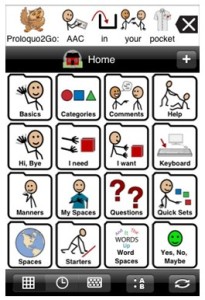Special Educators (yes, me included!) are excited about the new apps that have been popping up recently. If you know the time and effort parents and teachers go through to assist students that lack communication skills, you know how exciting this trend is. Students now carry visual schedules and stacks of picture exchange systems stuck to mounds of Velcro to communicate with others. If you have ever looked into purchasing an Augmentative and alternative communication (AAC) device you know that the price is astounding (almost $8000), not to mention some look clunky and almost prehistoric. For students with Autism, the need to fit in and socialize with their peers is essential and doing that with an AAC is next to impossible. Now, if these students had an iPhone imagine how “cool” and less obtrusive their communication could be!
Lisa Domican, mother of two autistic children, developed an app that she hopes will help others on the Autistic Spectrum develop better communication skills. The app is based on Picture Exchange Communication (PECS). The app known as “Grace”, named after Lisa’s daughter works just like the Picture Exchange Communication system. The child uses these pictures to make sentences or communicate needs and wants. The app was developed by Lisa in conjunction with software developer Steve Troughton-Smith, and with the support of Telefonica O2 Ireland. Grace, Lisa’s daughter, has become so comfortable with the app that she now adds pictures to the library using the camera on her iPhone. The app was also tested in the Saplings School in Rathfarnham for children with autism with great success. The app is now available in the iPhone app store for £29.99 (about $45.20 in USD).
Similar apps that are springing up in the app store to help facilitate communication are:
Look2Learn AAC – is a photo based (comes with 80) picture exchange and allows you to change sizes of the images. This app has also been trialed in Southern California school districts (only 4 buttons with vocal output). ($25)
The latest app from Look2Learn, is called Stories2Learn where one can create stories to develop proper social cues.
Picture Scheduler – this app shows is a virtual visual schedule providing a photo or video at a specified time as well as playing a voice note to cue the user ($3)
iConverse – An augmentative and alternative communication system that offers six choices with a pleasant voice and clip art icons ($10).
AutismXpress– this app helps students recognize facial expressions and different states of emotions. It’s a flash card type app, however, the faces move. The app was created for Autism Spectrum Australia (Aspect), which is the largest Autism support organization for Australia and the best part is , it’s FREE!
Proloquo2Go -provides a full-featured AAC solution for people who have difficulty speaking. It provides natural sounding text-to-speech voices (American and British English only), up-to-date symbols, powerful automatic conjugations, a default vocabulary of over 7000 items, full expandability and extreme ease of use.
I can only hope to see school districts buying iPhones or iPod Touches for their students with special needs. This will empower our students and give them a myriad of tools at their finger tips without making them stand out rather making them the envy of their peers!








3 Comments
This is awesome. My wife teaches kids with Autism and she just got an Ipod Touch for her birthday! I’ll make sure she checks this post out.
wow, thanks for the props there. Our app is a lot simpler than the ones that are based on existing AAC devices, but we wanted to encourage Verbal Behaviour in that the user must interact with a listener in order to have needs met. Autistic kids can mis-use the voca machines and apps, making sentences and pressing the “talk” button, without going to find someone to play the message to.
Having said that, my very verbal autistic son LOVES Proloque2go as he types his film credits and catchphrases into it and then gets them “scripted” back to him by the electronic voice. Saves me a lot of breath!
Grace also has a button for telling you where it hurts – so parents and carers can quickly prompt the user to choose the right picture for an obvious hurt like a scrapped knee, and then at the same time teach them all their body parts; the idea being they learn to tell you when something hurts on the inside.
anyway, thanks again xx
I am working on my masters in Autism Spectrum Disorder and it’s really exciting to see such quality apps emerging! I love hearing how individual children use them differently and the successes they have. I have also been told that ipads are now being used with those that lack the fine motor skills. I am looking into research and grants to try to get more devices and apps available to schools.
Thank you!